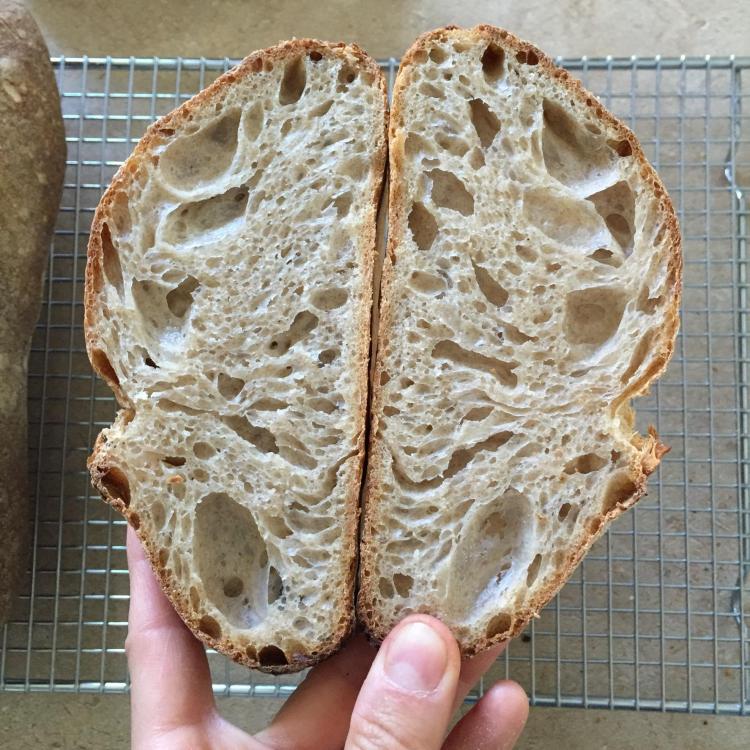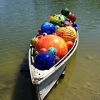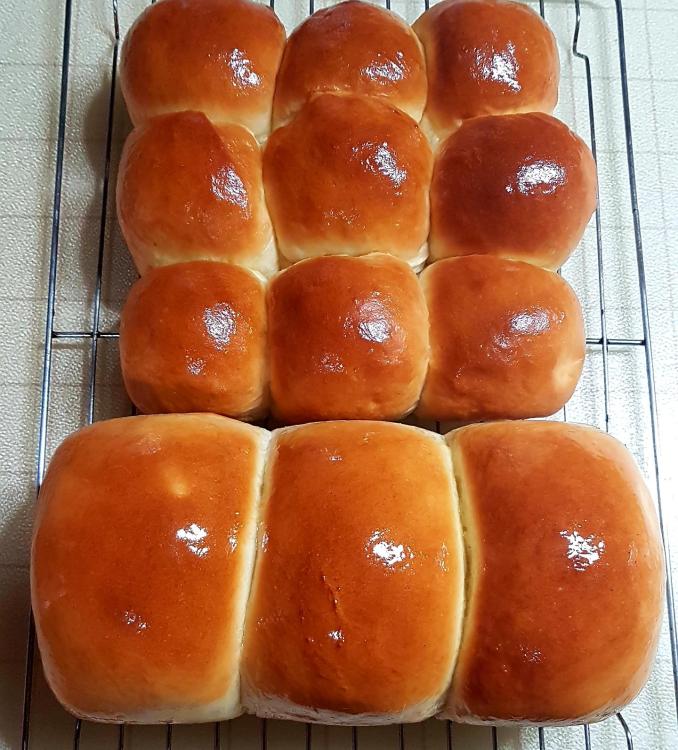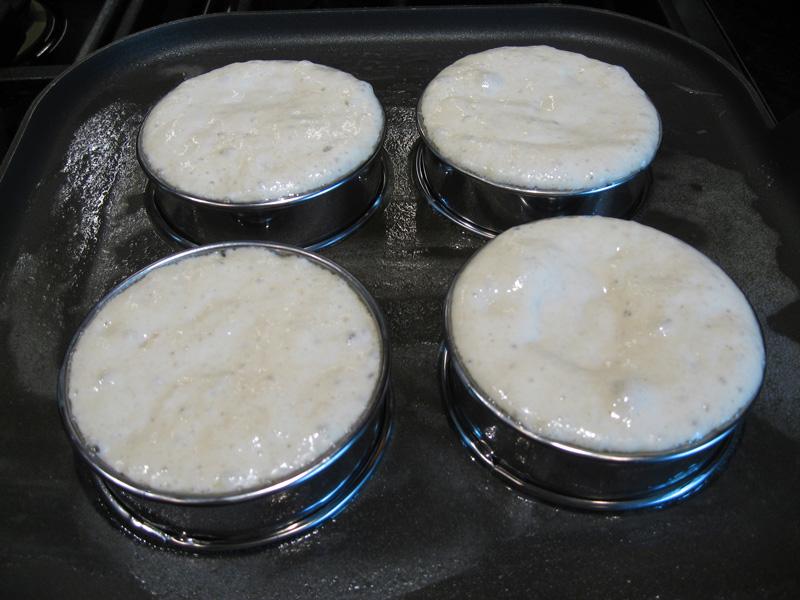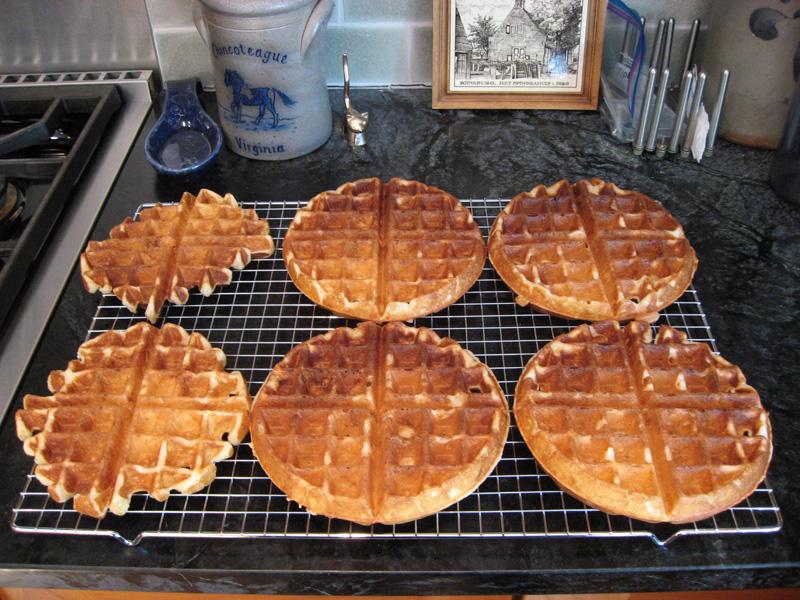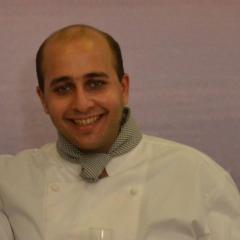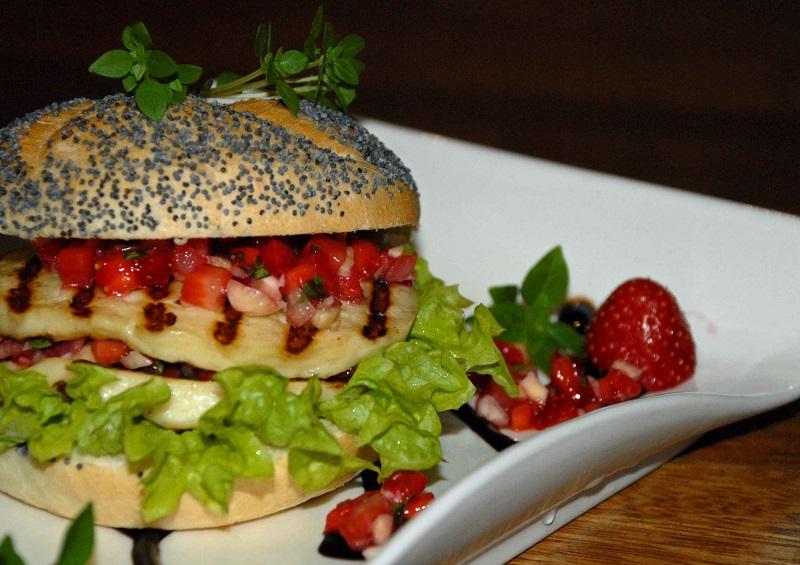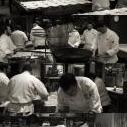Search the Community
Showing results for tags 'Bread'.
-
Host's note: this is part of a large topic that has been split into smaller segments to reduce the load on our servers. The previous segment may be found here: The Bread Topic (2015-2016). I've been trying to settle on a formula for a nice, basic, no frills sourdough which my friends (with zero interest in whole grains) can enjoy, and I think I've found my winner in a country white (10% w/g spelt) with 80% hydration. Mild, mild sourness despite the 12 hour cold proof. I want to try holding back some of the water to see if I can achieve better loft, but otherwise, I am happy with the formula.
-
How do you know when a homemade sourdough starter is ready to roll? I made the sourdough starter briefly discussed in the intro to Classic Sourdoughs by Ed Wood. It was 1 1/2 c. flour and 1 c. water sitting out at room temperature. After about 2 1/2 days (I stirred it down twice a day), it was about like bubbly muffin batter so I fed it with 1 cup flour and 1 cup water. Then it bubbled up to about twice the volume. In the book he says it is ready when you have one to two inches of foam on the top. Now I'm thinking beer foam or something like that. Instead I have a bubbly muffin batter. It is definitely alive in some sense as you can kind of see things moving if you stare at it long enough. Am I ready? Also, the book's recipes either specify a liquid culture or a sponge culture. It doesn't say which type I made but am I right to assume it is a sponge culture? You can kind of pour it (I needed to divide it because it was bubbling over the container) but it isn't as liquid as some sourdough starters I've had in the past. Thanks for any help you can give me! Nanette http://cookingincolor.blog-city.com
-
HOST'S NOTE: This post and those that follow were split off from the pre-release discussion of Modernist Bread. ***** Figured I don't need to dump all this into the contest thread - so I'll post here. My journey to making my first MC loaf. Her's the poolish after >12 hours: Not pictured - water with yeast in it below the bread flour and poolish That went into the mixer and not long later I had a shaggy mass: That rested for a while - then mixed until medium gluten formation - a window pane that was both opaque and translucent (no picture for that slightly messy part) Folded and rested, folded and rested, I think this is 1/2 the mass now ready to rest one final time. Proofed it in the oven - I have a picture of that but it's just foggy window oven Then it went into the oven, here it is at max temp - 450 with steam turned on. Completed loaf: \ And the crumb - this is awesome bread:
-
I can make, by my own admission , perfect sourdough, fantastic baguettes, delicious pizza (even approved by native neapolitans) but I cannot, even after multiple tries, make an acceptable focaccia. Mine always ends up overly dry or too oily. I've tried, as advised by some to use a pizza dough but this ends up too thin and crispy. Others end up as simply like a thin slab of bread. What I am looking for is a soft, delicate but slightly chewy bite with lots of open holes. The focaccia should be lightly but perceptibly oily, nicely salty and with a hints of rosemary or oregano in the topping. The focaccia should also have nice rise and be thick not thin like an unadorned pizza base. So come on egulleteers help me out and let's see those attempts for the perfect focaccia recipe!
-
Cool to see him using the same melanger that many of us have gotten from Premier. Interesting flavors and some information on recipe development. @Kerry Beal while their chocolate looks well tempered, they could probably use an EZ Temper to help with their workflow. 🙂 https://youtu.be/E2g-QZG4Vbg?si=pyK4eF2uxU1LTluj
-
Just had a marvellous al fresco dinner of bread and cheese. No nearby bakery produces sourdough baguettes which would have tasted even better. Occurs to me that I could learn how to make my own baguettes. I have successfully made focaccia with an overnight biga. Also make pizza with low yeast and a 3-7 day rest in the fridge. The bread tastes much, much better with a bit of fermentation. But I've had zero success keeping a sourdough culture alive, even after several starts. So I'd like help discovering information about short-term fermentations to add to bread, which don't require keeping the culture alive in the fridge; I don't even know what to search for.
-
Host's note: this was split from the I Will Never Again...(Part 4) topic. If I knew what I had done, you can bet I've never do it again. I've made only gluten-free bread before this in this Breadman machine with no problems. This time I was making a Challah, which I've made many times before in my old machine, a Regal, probably circa 1996, which I bought for $5 in a Moab second-hand store. I don't have the attribution of the recipe, but I have a feeling I found it either on eGullet or through a connection to eGullet. What I did wrong...I have no idea. None. Not a one. At least it's good for a laugh. Added: It still tastes good.
-
Light Brioche Bread Yield: One Bread Loaf Plus This should probably be called mock brioche because it is neither light nor is it actually brioche. But it is an excellent dough for sandwich bread, hamburger buns, cinnamon rolls or any use that calls for a soft, sweet bread. 3 1/2 cup all-purpose flour 2 1/2 teaspoons active dry yeast 1/4 cup sugar 1 teaspoon salt 1/4 cup butter, softened 1 large egg 1/2 cup warm water 3/4 cup warm milk In the bowl of a stand mixer, add the flour, salt, yeast, and sugar. Using the dough hook attachment, mix until the flour is completely aerated. Add the softened butter and mix until the butter is the size of crumbs. Stir in warm water, milk, and egg. You may not need all of the milk mixture. Add only until you have a soft, not sticky dough. Run the mixer on low (I use #2 on my Kitchen Aid) until a dough forms. Knead for 5 minutes, rest for 10 minutes and knead for 10 minutes longer. Remove from the mixing bowl and shape into a ball with a firm top surface. Place it on a cutting board or the surface of your counter and cover with a large bowl. Let the dough rise until it has doubled in size, 1 to 2 hours (See Note). This will give you about 30 to 32 oz. of dough, depending on your flour. I use 15 oz of dough for a loaf of bread and use the rest for dinner rolls, hamburger rolls, cinnamon rolls or whatever else that I decide to bake that day. If you have a scale, weigh each piece to guarantee that they’re all the same size. Shape the smaller rolls first and set to rise while you shape the bread. One way of shaping the loaf is to roll it to an 8 x 12 to 14 inch rectangle and starting at the short end, roll it, jelly roll style, into a loaf shape. Place it seam side down in a greased 8 x 4 inch bread pan. My preferred method of shaping bread dough is to shape it into three equal sized balls and place in a greased 8 x 4 inch bread pan. Plan on at least 45 minutes second rise for bread and at least 30 minutes for smaller items. Cover your bread with plastic wrap or a light damp cloth while it is rising. When the bread is finished with the 2nd rise, gently brush each one with milk. About 15 or 20 minutes before your bread has fully risen the second time, Heat your oven to 350o and place a skillet or metal baking dish on the oven floor. Before the dough goes in, add about 1/2 cup of boiling water to the pan to create steam. This will help keep the bread nice and moist. Bake the loaves for about 15 to 20 minutes or until golden brown. Smaller items will bake in 12 to 15 minutes. I like to brush the top of the bread with butter while it is hot out of the oven. Transfer to a wire rack to cool completely. Notes: Giving your dough enough time to rise is crucial in bread baking. Rise times will vary depending on temperature and climate. Be patient and let your dough, not your timer, tell you when it is ready.
-
Couldn't find a topic devoted to sourdough discard cooking, so thought I would start one and see how much interest it would generate. Moderators, if there is a topic, please merge. Recently I have begun making sourdough bread and am caring for a sourdough starter. Since there is currently some difficulty finding flour (due to COVID-19 related supply chain issues, etc.) I don't want to throw out any of my sourdough starter. I am also following guidance from King Arthur Flour and Cooks Illustrated for working with a small sourdough starter (10 g. flour | 10 g. water | 10 g. sourdough starter) and using recipes that use smaller amounts of sourdough starter or only building my starter up if called for by a recipe. I have made the following recipes and would make them again: - King Arthur Flour sourdough discard crumpets. https://www.kingarthurflour.com/recipes/sourdough-crumpets-recipe - King Arthur Flour sourdough discard waffles. I used a mix of yogurt & milk instead of buttermilk but otherwise made the recipe as written. https://www.kingarthurflour.com/recipes/classic-sourdough-waffles-or-pancakes-recipe What are you doing with your sourdough discard?
-
Ankarsrum, the Swedish mixer of many names: Electrolux Assistent, DLX, Verona, Magic Mill... I understand a few eGullet folks have these, or have had. Mine came this afternoon. From what I've read, mixing procedure with the Ankarsrum is different from mixing with planetary stand mixers. At the moment I need advice specifically with whether I should use the dough hook (with or without the scraper arm) or the roller attachment for my bread. The Ankarsrum manual says to use the dough hook for dough with between 1 and 1.5 liters of liquid ingredients. OK. My usual dough recipe uses 410 g of water. Rose Levy Beranbaum in The Bread Bible says to use the dough hook when mixing less than 4 pounds of dough. Which if my math is correct is about 750 g of water (math is not my thing). Beranbaum adds "For larger amounts, use the roller and scraper." Yet most bread recipes in the Ankarsrum recipe booklet that call for the dough hook use about a liter of liquid. The recipes that call for the roller use less liquid, 400-600 ml. Beranbaum is usually right but I'm wondering if she's wrong? Thoughts or suggestions? P.S. Sparkling Gold was not my first color choice. Sparkling Gold was perhaps not my thirteenth color choice. But Sparkling Gold was 10 percent off. Besides, the gold color matches the gold lettering on the bowl and dials. Now I feel better.
-
I've had my bread machine for about 2 years and love it - I love how quickly I can add the ingredients and a few hours later, I have a nice smelling house and often tasty loaf of bread. I don't remember buying a loaf of bread in these 2 years! Having followed numerous recipes, I feel I'm ready to get creative and try to devise my own combinations. But I'm scared - scared of wasting vast quantities of ingredients on recipes that fail to rise or are too stodgy. So, having seen the expertise available here, I was wondering if anybody can give me some tips on what ratios to absolutely stick to and how to adjust it for different ingredients - e.g. adding cheese = less oil. I know it's not this simple (and adding cheese probably doesn't = less oil) so I'm here to hear your wisdom and guidance! Apologies if this has been asked before - I couldn't find anything other than an extensive conversation about yeast
-
I live in India and we dont generally get bread flour out here. We have basically AP flour, about 11% protein content. I've tried out recipes i've found on various websites and books, and i've found that lack of gluten tends to become a problem. I have gluten powder available and was wondering if there is a general proportion of gluten powder to add to AP flour to use for breads. It'd be great if someone could help me out, especially if the proportion is in terms of weight rather than volume. Thanks
-
Ive been reading numerous articles, blogs, etc where people mention that they use a Romertopf for baking breads, including the no knead bread. I am still a bit confused because there are mixed commentary on whether to soak or not to soak prior to popping the baker into a cold oven. Can anyone who owns a Romertopf and uses it for no knead share your method for no knead and whether you soak it or just preheat? I would like to make an enlongated version of this bread and have made an ok circular bread with my chamba pot. The Romertopf that I own is unglazed and its the medium size that can hold a whole chicken. (111) i think.
-
Hello all, In attempt to make it easier to work high hydration dough, I had a thought about using gelatin and water in order to make jello cubes, and incorporate them into the kneaded dough. The idea is that unlike extra water, the jello will not have much adverse effect on the dough texture, stickiness and ease of handling. However, when baked, the gelatin will dissolve and allow the water to boil into steam and effectively increase the hydration, resulting in more aeration, raise and moistness. I tried it once, reducing apx. 7% water from the dough and folding in 7% gel after kneading. However, I mistakenly made too weak of a gel, and it just melted into the dough. Shaping wasn't easier then usual (sticky as always ). The bread did bake as usual, with no ill effects. I think I should try it again, replacing 15% of the water with much stronger jello. I'd like too hear your opinion, am I wasting my time or does it make sense? I thought it might also theoretically work in laminated dough, possibly replacing some of the butter?
-
Ever seen this cooking technique ? A reference with pictures in italian language. Could'nt find any in english. http://cheprofumino.blogspot.it/2009/02/la-nostra-pizzasenza-forno.html
-
The team behind Modernist Cuisine: The Art and Science of Cooking is hard at work on their next multivolume set, which is completely dedicated to bread. For the new book, we’d like to honor some of the greatest regional and hyper-regional breads from around the globe and we would love to hear from the eGullet community to expand our search. In your opinion, what are the breads that your city or region is known for? What are the loaves that you can’t find anywhere else? Example: Stretch bread, Syracuse, NY You can read more about the new book here, and here for more information about who we are and what we do.
-
The team behind Modernist Cuisine: The Art and Science of Cooking is hard at work on their next multivolume set, which is completely dedicated to bread. We’d like to honor some of the greatest bakers and bakeries from around the globe in our new book, and we would love to hear from the eGullet community to expand our search. What are your favorite bakeries for bread? Does the bakery have an iconic bread that they’re known for? Do they use any uncommon ingredients or special techniques to make their bread? Please provide the address of the bakery, name of head baker, and a photo of the bread, if feasible. For example: Country Bread from Tartine in San Francisco, CA – Chad Robertson, baker You can read more about the new book here, and here for more information about who we are and what we do.
-
The folks behind Modernist Cuisine have announced a projected publication date of March 2017 for their new five-volume set on bread (previously discussed here). Start saving up now!
-
San Diego has a small number of artisanal bread bakeries. Bread & Cie has been my favorite for years, and their breads are now available in many supermarkets, which is very convenient. But it's nice to have some variety. So I was excited to spot a new bakery this weekend in Linda Vista. It's called Pacific Time and it is also a sandwich place with a small market with things like small-batch preserves, local beers, a cheese counter, charcuterie platters, and wine. It's located within a recently renovated strip mall that also hosts Brew Mart & Ballast Point. The bread I bought was a French-type rustic boule, dark, a bit reminiscent of Poilane but less dense. The crust could have been a little more crispy (it felt like the bread had sat around a little bit and softened in the paper bag), but the flavor was wonderful. Here is the bread:
-
I want to leave my sourdough (itself, not baked loaves of sourdough bread) for a while (going abroad) but I do not want it to die, can I leave it in the freezer? do you have other ideas?
- 7 replies
-
- Bread
- Troubleshooting
-
(and 1 more)
Tagged with:
-
Hello there, I need a book that will teach me the secret science behind baking and free me from recipes. I am developing a blog that will focus a lot on baking. I will be developing my own recipes so I need guidance on the science behind baking. I have read "Ratio" by Michael Ruhmlman and even though it is great I find it somewhat incomplete. In the section of cakes, for instance, he addresses the ratio (1:1:1), the methods (creaming and foaming), and he gives wonderful variations for the basic recipe. He doesn't, however, address the issue of adding cocoa powder to the batter. Cocoa powder, in my view, is not merely a flavoring, it has the potential to interfere with the balance of a cake. If I add cocoa powder, do I decrease the amount of flour? If I decrease the flour amount, should I also decrease the sugar amount? "Ratio" also left some questions unanswered in the cookie section. Ruhlman gives the basic 1,2,3 ratio, but he doesn't really address that some cookies, for instance, have eggs in them. He doesn't address the role each ingredient has. What makes a cookie crumbly or crunchy? What makes it gooey? What makes it soft and cakey? I know that flour and eggs give structure to baked goods, and sugar and fat give it tenderness. But I need a book that addresses in depth the role of each ingredient, along with its percentage.Is there such a book in the market? I understand that no single book might address all the questions I have, but what books would be a good starting point for me?
-
Today I would like to share with you a recipe for a slightly different sandwich. Instead of traditional vegetables, I recommend strawberry salsa, and rather than a slice of ham – a golden grilled slice of Halloumi cheese. Only one thing is missing – a fresh and fragrant bread roll. Halloumi is a Cypriot cheese made with sheep's milk or a mixture of sheep's, goat's and cow's milk. It is semihard and so flexible that it is excellent for frying and barbecuing, and it is great fresh too. Ingredients (for two people) 2 fresh rolls of your choice 2 big lettuce leaves 4 slices of Halloumi cheese 2 teaspoons of butter salsa: 8 strawberries half a chili pepper 2 tablespoons of minced peppermint leaves ¼ a red onion 2 tablespoons of chopped almond without the skin 1 teaspoon of honey 2 tablespoons of lemon juice 2 tablespoons of balsamic sauce Start by preparing the salsa. Wash the strawberries, remove the shanks and cube them. Dice the onion and chili pepper. Mix the strawberries with the onion, chili pepper, peppermint and almonds. Spice it up with honey and lemon juice. Leave in the fridge for half an hour. Grill the slices of Halloumi cheese until they are golden. Cut the fresh rolls in half and spread them with butter. Put a lettuce leaf on each half of roll, then a slice of the Halloumi cheese, one tablespoon of salsa, another slice of cheese and two tablespoons of salsa. Spice it up with balsamic sauce. Cover with the other half of the roll. Prepare the second sandwich in the same way. Serve at once while the cheese is still hot. Enjoy your meal!
-
How to Make Rye Sourdough Bread I don't know what it is about bread, but it is my favorite thing to make and eat. A freshly baked loaf of bread solves a world of problems. I was lucky enough to get to be one of the main bakers when I worked at the Herbfarm. We baked Epi, Baguettes, Rolls, Pretzels and so much more. Rye Sourdough Wood Oven Baked Bread My fondest memory when I worked there was our field trip to the Bread Lab(wait something this cool came out of WSU, of course!) here in Washington. They grow thousands of varieties of wheat and have some pretty cool equipment to test gluten levels, protein, genetics and so on. I nerded out so hard. What came out of that trip was this bread. Now I can't recall the exact flour we got from them, but using a basic bread and rye will do the trick. We used to get a special flour for our 100 mile menu. This was where we were limited to only serving food from 100 miles away. So finding a wheat farm that made actual hulled wheat in 100 miles was a miracle. The year before...the thing we made, was closer to hard tack. Now if you don't have a starter, I recommend starting one! It is a great investment! Rye Sourdough 1000 g flour (60% Bread Flour, 40% Rye) 25 g salt 75 g of honey/molasses 200 g of Rye starter 650 g of water, cold Equipment Baker Scale (or other gram scale) Bench Cutter Bread Razor (you could also use one of those straight razors) Start by taking the cold water, yeast and Honey and mix together and let sit for 10-15 minutes I know, some of you just freaked out, cold water? Won't that kill the yeast. Nope, the yeast just needs to re hydrate. I prefer using cold water to slow the yeast down. That way the lactobacillus in the starter has a good amount of time to start making lactic acid, and really get to flavor town! While that is sitting, I mix the flour and the salt together(How many times I have forgotten to salt the bread). Now mix the two products with a kneading hook for 3-5 minutes, only until thoroughly mixed but not yet at the window pane stage of kneading. Instead, place into a bowl and set a timer for one hour. Then when that hour is up, push the dough down and fold all the corners in Repeat this step 2-3 more times, pending on the outside temperature. If you happen to have those cool bowls to shape round loafs! Awesome, use them. I would break the boules into 3 balls of about 333 grams If not then just put the dough in the fridge and do the steps below the next day. Once you have bouled the bread, can put it into the fridge and let it sit over night Again, this lets the bacteria, really get to work(misconception is the yeast adds the sour flavor, nope, think yogurt!) Now on the next day, heat up whatever form of oven you plan to use. We used a brick oven but if you just have a normal oven, that is fine. Crank it to 450 degrees Fahrenheit. If you have not bouled your bread yet, go back and watch the video and break the dough down into three balls of abut 333 grams. Then place the balls on a lightly greased sheet pan. Let sit for about 45 minutes to 1 hour. If you have used the fancy bowls then turn the the bread out on a lightly greased sheet pan, without the bowl and let temper for 15-30 minutes. If your oven is steam injected, build up a good blast of steam. If not, throw in a few ice cubes and close the door or put a bath of hot water inside. The steam is what creates the sexy crust! Let it build up for a few minutes! Right before you put the bread into the oven use a bread razor to slice the top of the bread. Place the dough balls into the oven and douse with another blast of steam or ice and close the oven. Let them bake for 13 minutes at 450 degrees. Then turn the loaves and bake for another 10 minutes. Remove when the crust is as dark as you want and the internal temperature exceeds 190 degrees Fahrenheit. Now pull out and make sure to let cool off of the sheet pan with room to breath underneath. You don't want your crust steaming! Now here is the hardest part, wait at least 20 minutes before getting into the bread. Also, cutting into bread to early really seems to come out poorly. I would rip the bread until 1-2 hours has passed. Now serve it with your favorite butter, goat butter or whipped duck fat!
-
Hi, I have just discovered and registered on this site. My main cooking and baking concern is that I have been diagnosed with Celiac Disease and haven't been able to eat gluten. BUT I have discovered an exception. When I have visited Continental Europe such as Spain and Russia, I have been able to eat their bread and have had no negative repercussions. Then when I try eating bread in Great Britain and North America I have become sick. My research on the Web has not provided any explanations although I believe the EU has banned GMO grains. I was recently gifted panetonne from a Toronto restaurant called Sud Forno that uses Italian flour and I was able to safely eat it. Another bakery called Forno Cultura advertises that it uses European flour. So I am going to approach them to see if I can buy their flour in bulk. I will let you know how it goes.


